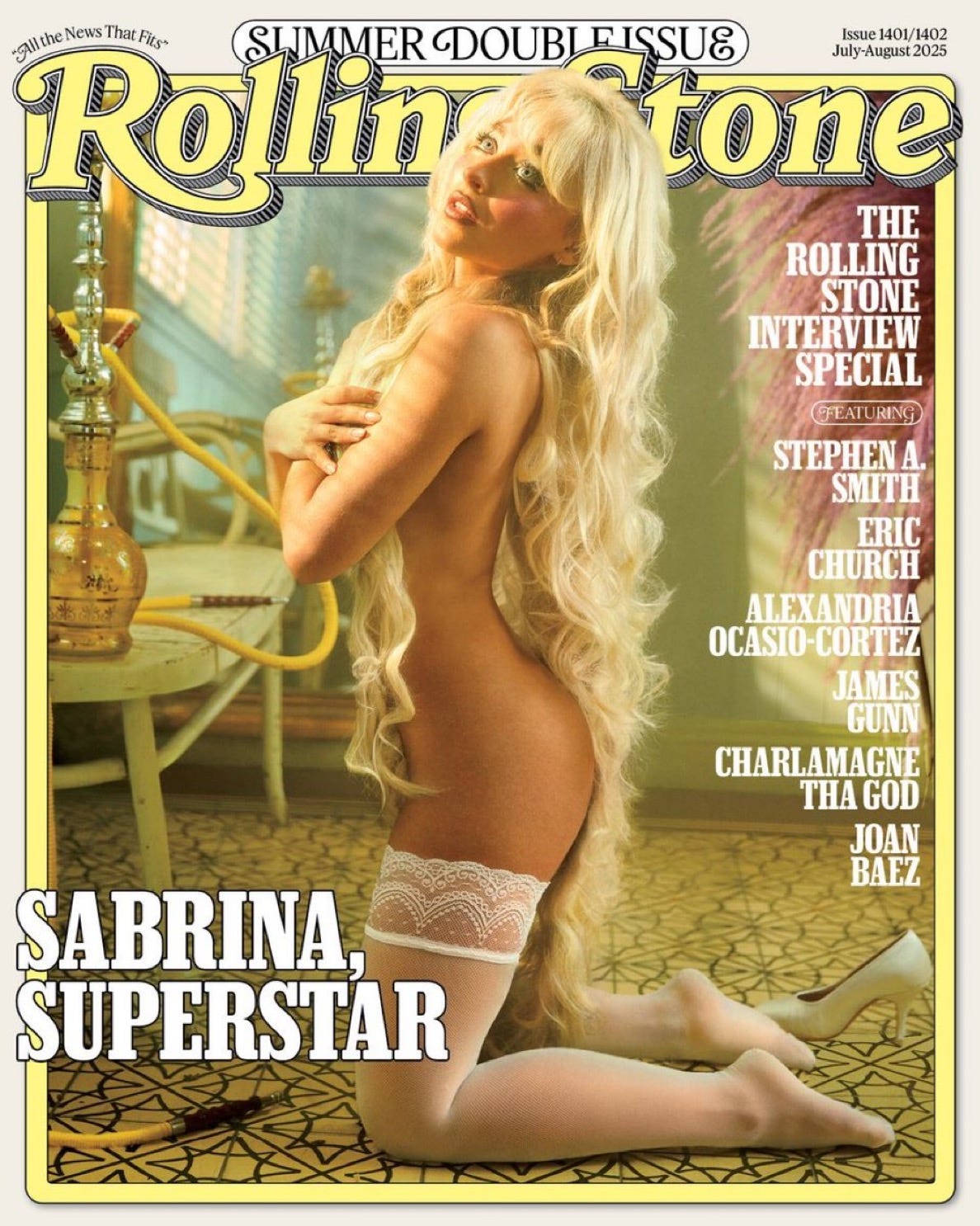Can Pop Girls Do Subversion? Sabrina Carpenter and the ‘Female Gaze’
Look at our feminists Dawg...we're never making it out the patriarchy...
Sabrina Carpenter’s appeal is undeniable: her retro aesthetic, clever lyricism, and breezy, perpetual-summer persona have solidified her status as a Gen Z pop darling. However, a recent promotional image—reportedly tied to her forthcoming project Man’s Best Friend—has sparked widespread controversy. In the image, Carpenter is shown on her knees with a faceless man gripping her hair, conjuring disturbing power dynamics that many have interpreted as evoking themes of misogyny. When paired with the album’s provocative title, the visual has been seen by critics as a troubling nod to gendered submission. While some fans defend the image as ironic or subversive, others—including myself—argue that it is tone-deaf, reflecting a broader cultural backlash against feminist progress.
This backlash can be understood within the wider context of what Francis Fukuyama (1989) famously described as “the end of history”—the moment at which liberal democracy and market capitalism have emerged as the uncontested ideological endpoint. Fukuyama’s thesis predicted not just the triumph of Western liberal democracy over communism, but also an ideological stasis where alternative political visions and subcultures lose their potency or are absorbed into the dominant market framework. This has profound implications for how cultural resistance operates today.
In a world where the market reigns supreme, resistance and movements are commodified and depoliticised. They lose their oppositional edge and instead become aesthetics, packaged and sold to consumers as lifestyle choices devoid of their original political meaning. Carpenter’s image is symptomatic of this: rather than challenging patriarchal norms, it repurposes tropes of female submission and sexualised imagery for commercial appeal, blurring the lines between critique and complicity. It fits neatly into the postfeminist logic where empowerment is redefined as individual sexual confidence divorced from collective political struggle, consistent with Angela McRobbie’s warning about the depoliticisation of feminism in late capitalism.
Another defence posits that Carpenter is appealing to the female gaze. However, this raises questions about what the female gaze entails in a media landscape still saturated with patriarchal norms. John Berger (2018) famously argued that the male gaze—rooted in art criticism historically dominated by men—shapes how women are culturally and socially perceived. According to Berger, Western notions of ‘high art’ are inextricably linked to colonial ideas of progress and “sexually commodified women” (Wanzo, 2016), establishing a visual culture in which women are not only seen but shaped by how they are seen.
Laura Mulvey (1989) expanded this idea in her seminal work on film theory, arguing that in cinematic representation, women function primarily as signifiers for the male subject, who imposes his fantasies onto a passive, silent image of woman. Women, therefore, are not makers of meaning but bearers of it—existing as the "male other" within a patriarchal symbolic order. This theoretical framework is relevant beyond cinema, particularly in the age of social media, where women often internalise and perform for the male gaze. These performances, filtered through algorithms and hyper-visibility, reproduce unattainable beauty ideals and reinforce gendered power dynamics.
However, the male gaze has not gone unchallenged. bell hooks (2012) critiqued Mulvey for failing to account for race in her analysis, noting that white femininity is often centralised, while Black women and other women of colour are excluded from visual subjecthood. hooks challenges the binary framing of gaze as male versus female, instead arguing for a more nuanced understanding of how race, class, and sexuality intersect in practices of looking and being looked at. This critique is vital in discussions of figures like Carpenter, whose whiteness affords her a particular kind of cultural legibility and aesthetic power within the Western pop landscape.
In light of these theories, Carpenter’s imagery becomes less a statement of liberation and more a performance of curated submission dressed up in nostalgic glamour. Rather than disrupting patriarchal narratives, it risks reproducing them—albeit with a glossy, Instagrammable sheen
This is indicative of the coquette aesthetic —popularised by figures like Lana Del Rey—illustrates this evolution perfectly. Emerging as a reaction against ‘girlboss’ feminism (itself a digitised, market-friendly postfeminism), the coquette aesthetic embraces a hyperfeminine, nostalgic vision of womanhood that is at once aestheticised and depoliticised. As Mooney (2018) notes, the sad girls’ rebellion is less about dismantling capitalist patriarchy and more about reclaiming femininity as a consumable identity—one often accessible only to privileged white women shielded from the harsher realities of systemic oppression.
Fukuyama’s “end of history” thus serves as a useful framework for understanding why Carpenter’s imagery—and the coquette aesthetic more broadly—fail to provoke meaningful political disruption. In the absence of viable alternative ideologies, all forms of dissent become commodified, repackaged for aesthetic consumption within the marketplace. The political edge of subcultures dulls, replaced by depoliticised performances of identity that conform to market logic.
Additionally, Carpenter recently appeared on the cover of Rolling Stone, photographed by the iconic David LaChapelle. Once again, she is posed on her knees, gazing upward into a ray of sunlight that washes over her bare body—a visual that evokes passivity, submission, and a kind of spiritual ecstasy. Yet the most striking element of the image is its setting. Behind her sits a shisha pipe; the backdrop features tiled walls, lush fabrics, and a low-lit ambiance that resembles the Western fantasy of a Middle Eastern “villa” or harem. This highly stylised scene draws on classic orientalist iconography—one that Edward Said (1978) critiqued as the West’s construction of the East as timeless, exotic, sensual, and static.
Carpenter’s portrayal sits within a lineage of orientalist visual culture, but it also revives a specific aesthetic rooted in the 1960s counterculture, when hippies and Western bohemians began to embrace Eastern mysticism as part of a rebellion against capitalism, materialism, and Western rationalism. This embrace, however, was often superficial and appropriative. Rather than engaging with the philosophical depth of Eastern religions or traditions, the movement cherry-picked symbols—incense, mandalas, turbans, meditation, yoga, hookah—as decorative and spiritual accessories. Middle Eastern and South Asian imagery became shorthand for liberation, sexuality, and anti-establishment cool, stripped of historical or cultural context.
In this sense, Carpenter’s Rolling Stone cover doesn't just echo old orientalist fantasies—it also reproduces the hippie-era fetishisation of the “mystical East,” where non-Western symbols are aestheticised to conjure a vague sense of spiritual sensuality. This kind of visual language serves Western narratives of self-discovery and eroticism while keeping the cultural origins in the background, flattened and reinterpreted through a Western gaze. The result is a layered form of cultural appropriation: one that simultaneously eroticises and spiritualises the East, positioning it as a backdrop for white female self-expression and sexual liberation.
Subversion only resonates when it's grounded in a clear and intentional political critique. In Sabrina Carpenter’s case, that foundation feels absent. Her provocative imagery—particularly in the context of current cultural regressions—doesn't dismantle patriarchal power structures but instead repackages them for aesthetic consumption. Rather than offering a pointed feminist commentary, her work seems more concerned with selling a fantasy of sexual confidence that comfortably aligns with commodified postfeminist ideals. Angela McRobbie warns of this very phenomenon: the depoliticised celebration of female empowerment that, in reality, reinforces the same systems it pretends to resist. bell hooks similarly cautions against conflating sexual visibility with liberation, especially when race, class, and structural power are ignored.
At a time when feminist gains are being openly challenged—from rollbacks on reproductive rights to the resurgence of tradwife discourse—playing into submissive fantasies and pet play aesthetics without critical framing feels not only tone-deaf but actively complicit. Unlike Madonna, who famously used her sexuality to critique institutional power (notably the Catholic Church), Carpenter offers no such disruption. What remains is an aesthetic that masquerades as subversion, but functions more as a glossy reinforcement of the backlash itself.
At a time when feminist gains are being openly challenged—from rollbacks on reproductive rights to the resurgence of tradwife discourse—this depoliticised, commodified feminism is not just tone-deaf; it is actively complicit in the backlash. Unlike Madonna’s politically charged provocations, Carpenter’s work offers a sanitised spectacle that aligns comfortably with late capitalism’s “end of history” and the depoliticisation of dissent.





